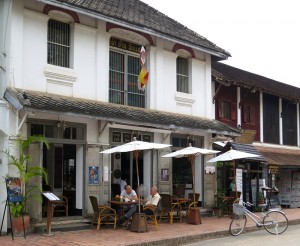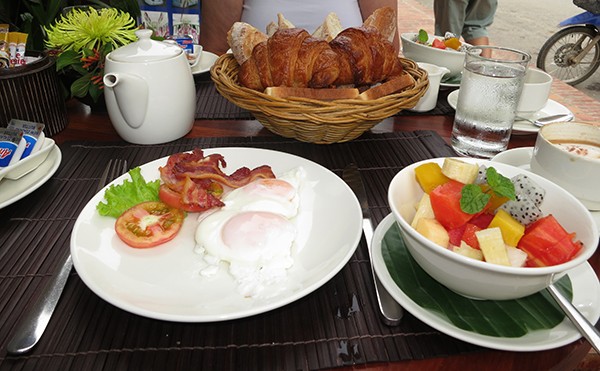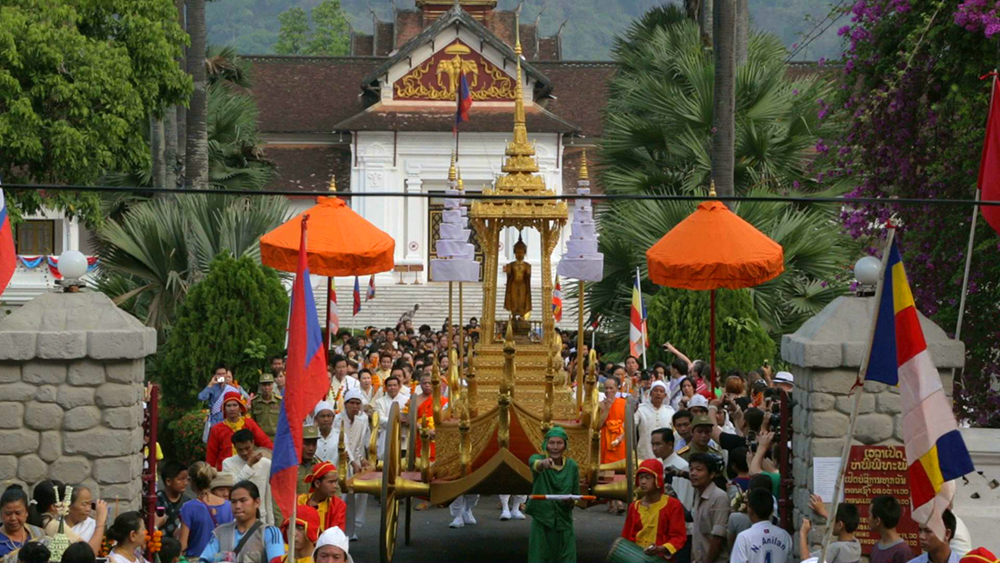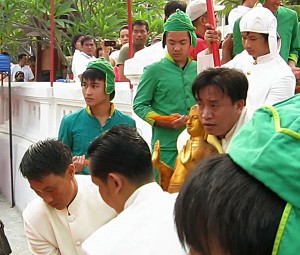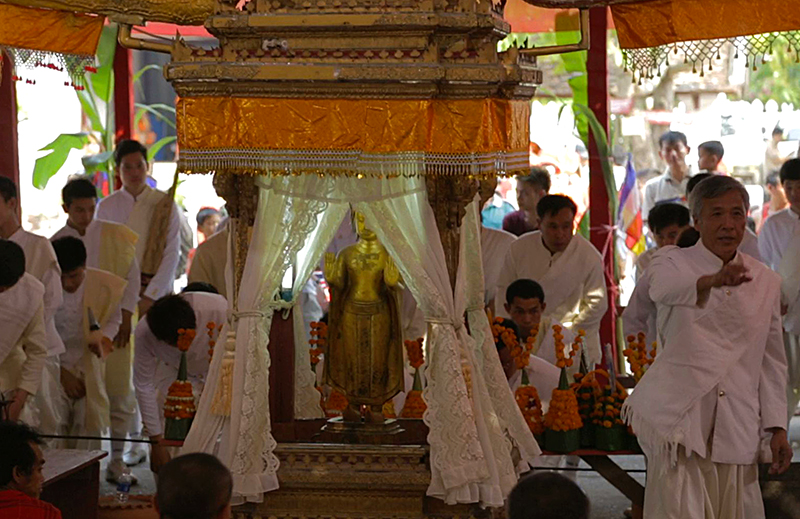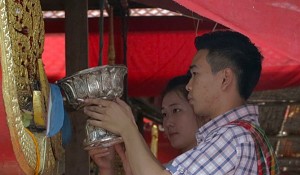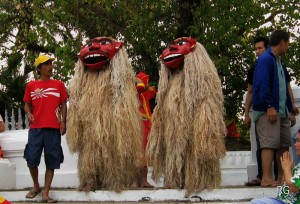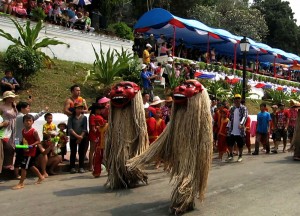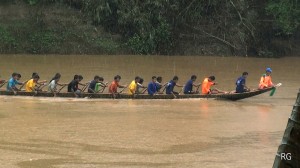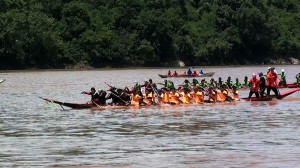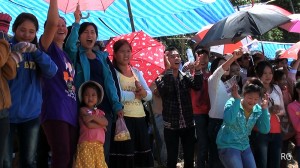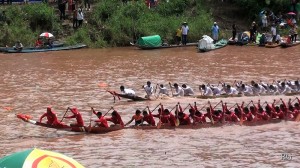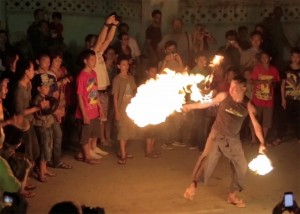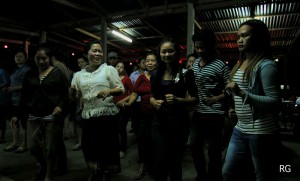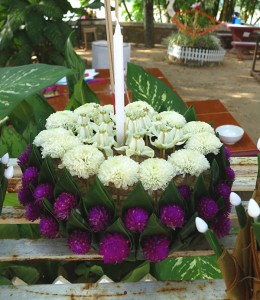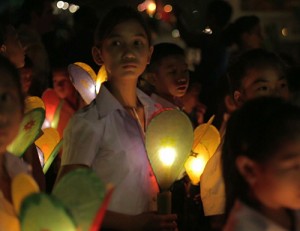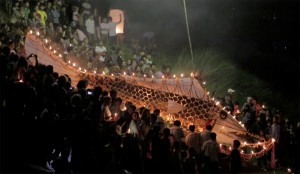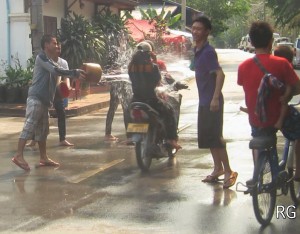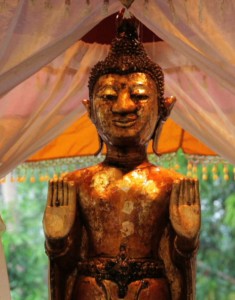I am fascinated by cultural stories of non-western people and one fascinating story is the one in Luang Prabang, Laos about the four faced god, Ka Bin La Phom.
Not only does the god personify a whole value system, he also features very prominently in the lunar new year celebrations each year.
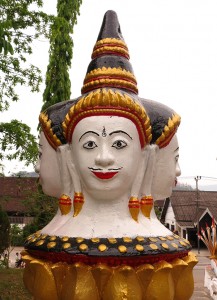
A statue of Ka Bin La Phom at the top of stairs leading to Wat Mahathat
If you walk up the stairs leading from the main road into Wat Mahathat you will pass through a gateway featuring the god’s head on the top of the ornate gate posts. In his four faces are four guiding principles which people believe gives guidance on how to interact with people – especially your children.
The four things exemplified in Ka Bin La Phom’s four faces you should use in any interaction are:
- Loving Kindness,
- Compassion,
- Sympathy, and
- Neutrality.
Sounds good to me and from my interactions with Lao people, I think they take this lesson fairly seriously.
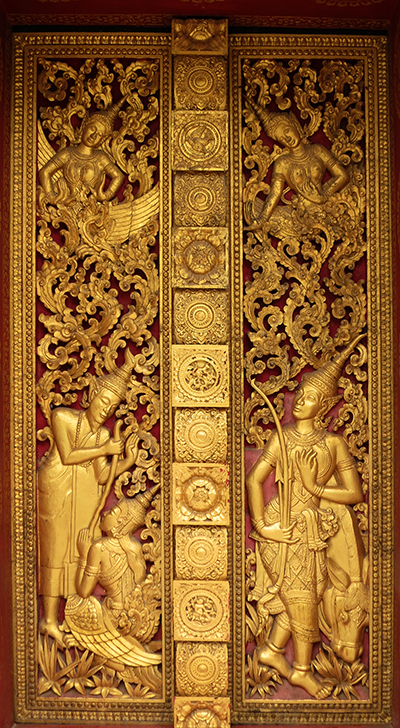
One of the beautiful entry doors to Wat Mahathat
But, Ka Bin La Phom plays a strong part in Lao New Year, or Pi Mai. Yes, I know there is a lot of water throwing and mud smearing and drunkenness too, but there is a serious religious side to the festival and the parade through town and the blessings at the Pac Ou Caves are serious affairs – featuring Ka Bin La Phom.
Let me tell you the story as it was told to me by our friend and guide Lathasak Manilatsamy.
Ka Bin La Phom created the world and its people and remained the god of the sky. It was the custom for people to ask his advice to solve problems or to grant them their wishes. But the people started to favour asking a learned man called Tamaban to solve their problems. Tamaban had studied a lot and had actually learnt to speak the languages of the birds and beasts of the forest.
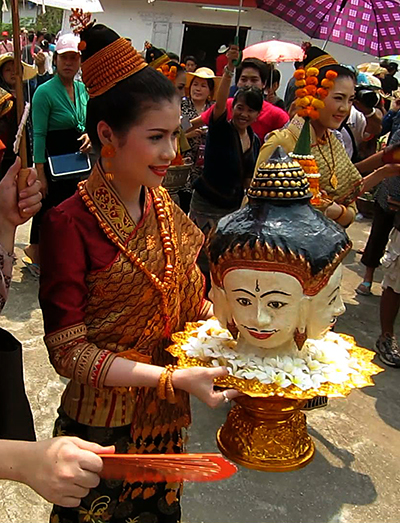
Ka Bin La Phom is carried by the current Miss “Lao New Year” at Wat Mahathat
In time, people started to forget Ka Bin La Phom and he became jealous and angry. So he decided to set Tamaban a problem to show the people who was the smartest. So he came down to earth in human form and showed himself to Tamaban and the people. He told Tamaban that they were now in a life and death struggle – after the competition either Tamaban or Ka Bin La Phom would die.
To save himself, Tamaban had to answer three questions:
- Where is the sin of the people in the morning?
- Where is the sin of the people in the afternoon?
- Where is the sin of the people in the evening?
Ka Bin La Phom told Tamaban that he would return in seven days to hear his answers – expecting that Tamaban would not have the answers.
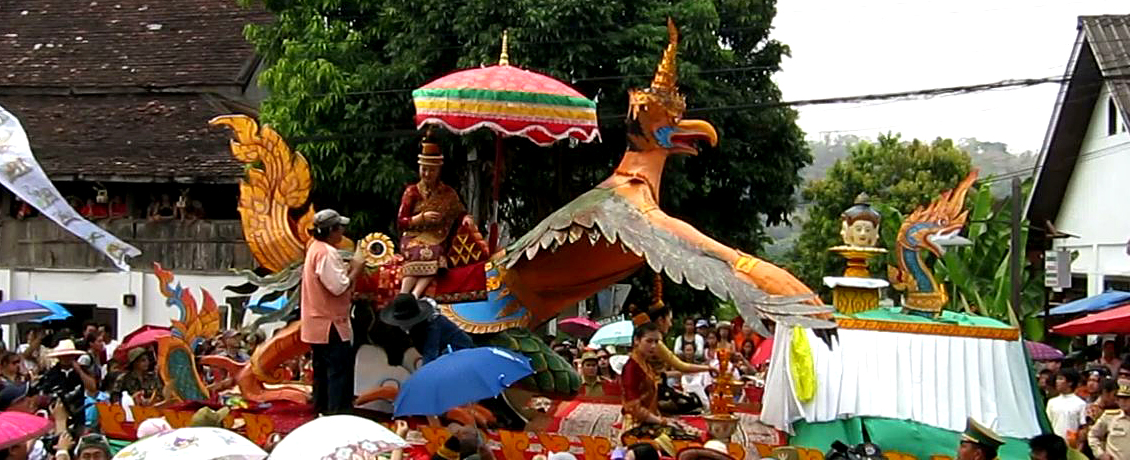
With Ka Bin La Phom at the front of the float, the daughters take up positions on and under a Garuda
And he would have been correct because Tamaban did not have any idea what the answers were. For six days he thought, asked people and prayed for the answers – but they did not come. So, in fear of his life, on the sixth day, he ran away into the deep jungle.
He clambered for hours through the dense jungle and becoming very tired, he lay down under a huge tree and as he lay resting two large eagles landed in the branches.
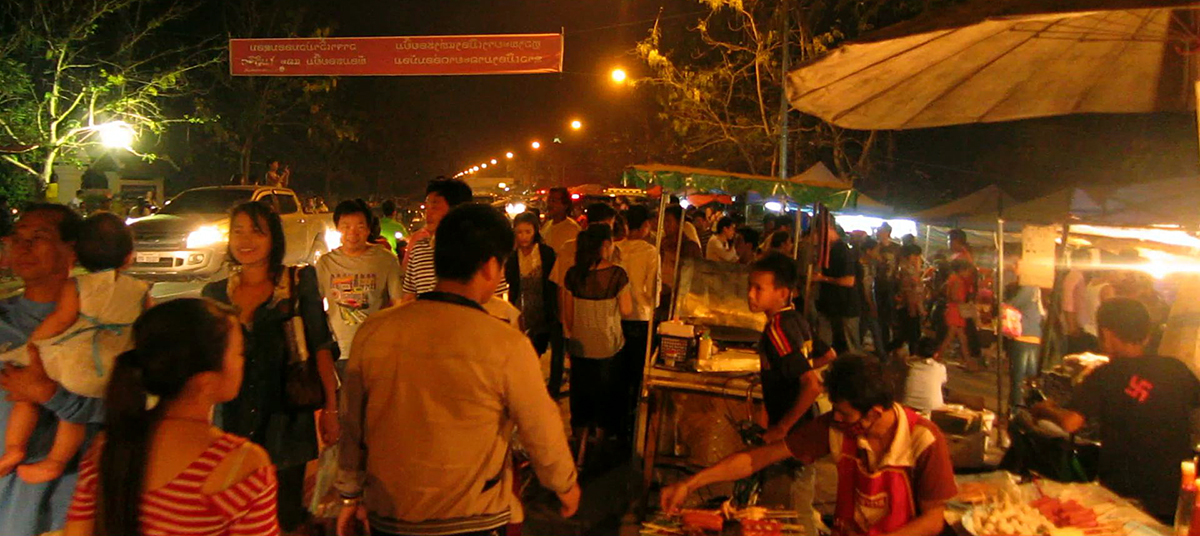
Crowds arriving at the Miss Lao New Year Competition
Not realising that Tamaban could hear them, Mrs Eagle said to Mr Eagle “I am very hungry. Will we get anything good to eat tomorrow?”
Mr Eagle replied “Tomorrow we will have a treat. The god Ka Bin La Phom has asked a man called Tamaban three questions and if he does not give him the answers tomorrow, Ka Bin La Phom will cut off his head and we will have days of feasting on his flesh.”
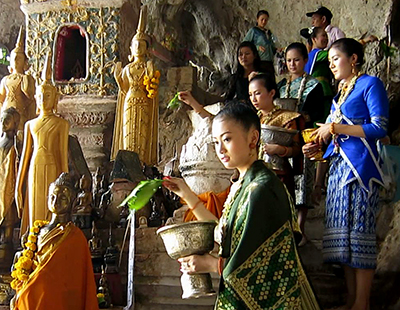
The daughters of Ka Bin La Phom sprinkling holy water on Buddhas at Pac Ou Caves
“That’s good news,” said Mrs Eagle, “But what are the questions and do you know the answers?”
“Listen, and I will tell you the questions and the answers,” said Mr Eagle – and he did, while hiding below them, Tamaban listened intently. When they were finished, Tamaban ran back to his village.
On the seventh day, Ka Bin La Phom returned and confronted Tamaban.
“Well, do you have the answers or shall I cut off your head?” he asked.
“I have your answers” said Tamaban boldly.
“The sin of the people in the morning is on their faces so they wash their faces before they start the day.
The sin of the people in the afternoon is on their bodies so when they come home from the fields they wash the sin away and refresh themselves.
In the evening, it is on their feet so before going to bed, they wash their feet.”
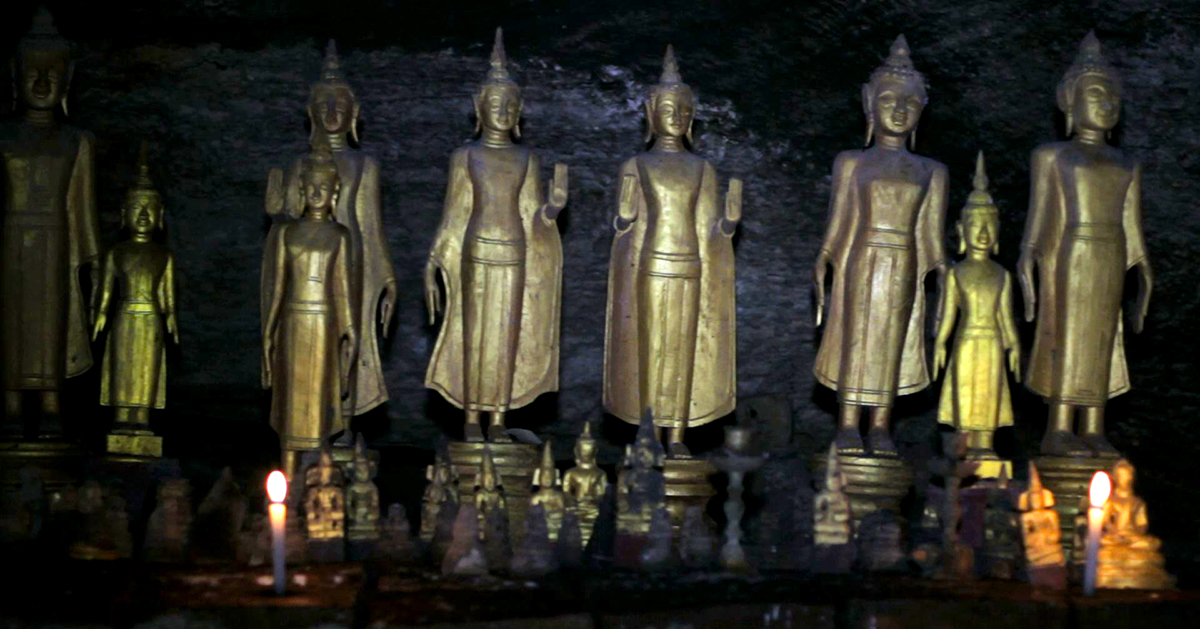
Some of the Buddha statues inside the caves at Pac Ou
“You are correct!” exclaimed an astounded Ka Bin La Phom, “and as I promised, I will now cut off my own head instead of yours. But, this will be very dangerous for human kind and you must follow my directions or the world will come to an end!”
With that, he called his seven daughters to him and explained to them what they needed to do. He told them that once his head was cut from his body it would be very dangerous. If it was placed on the ground, the earth would catch fire and burn to dust. If it was placed in a river or stream, all the water in the land would boil away and if they threw it into the air, the air itself would catch fire and all life would perish.
To make the head safe, it would have to be placed on a golden platter and kept inside a cave – except for once a year, when it must be brought out to be venerated and washed in holy water.
And this is the ceremony that takes place every Lao New Year.
The seven daughters are picked in a huge contest for their looks as well as their character and intellect. They bring the god’s head out and venerate it in a building inside Wat Mahathat. It is then carried in procession from Wat Mahathat to Wat Xien Thong where it can be worshiped before returning it to its resting place.
The seven daughters also visit the ancient caves north of Luang Prabang which overlook the Mekong just where the Ou River flows into the Mekong.
Here, the daughters sprinkle holy water on the hundreds of Buddha statues crowded into the caves .

Worshipers leaving Pac Ou by canoe
